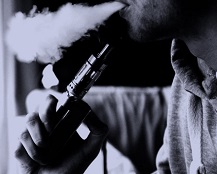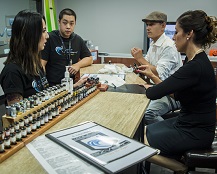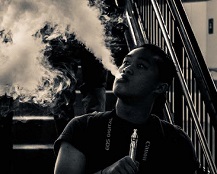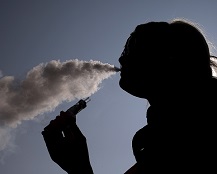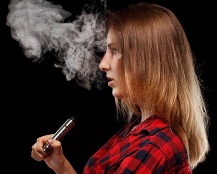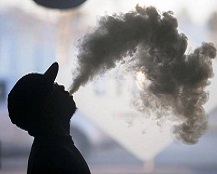A new study looking at the effect of e-cigarette vapor on human airway cells has found no sign of toxicity, with the vapor-exposed cells faring about as well as the air-exposed ones. The new finding adds further evidence that the risks associated with vaping are likely to be very small, and almost certainly much less than the risks of smoking.
For those intent on claiming that e-cigs are a gateway to conventional cigarettes, the new Monitoring the Future study has a pretty devastating result: it turns out, most teen vapers don’t even use nicotine.
The CDC has released the next set of National Youth Tobacco Survey data, and despite spending the last few years continually harping on about the rising use of e-cigarette by youth and its potential as a gateway to smoking, the “concern” is growing less and less believable, as the data strongly suggests that e-cigarettes are actually causing dramatic declines in youth smoking.
A new study has investigated the flavoring chemicals in e-liquids, and has generated some concern in the media about their risks, with Time using the headline “E-cigarette flavors may be dangerous, study says.” But is this another example of overstating a minor risk for the purpose of spreading mistrust of e-cigs, or is there actually something to it?
A new study looking at one-year quit-rates for smokers purchasing their first e-cigarette has found that around 41 percent quit smoking entirely and another 25 percent reduced their cigarette consumption by at least half. The finding contradicts claims that there is no evidence e-cigarettes help you quit smoking, and joins other research in suggesting that quit-rates with e-cigs dwarf those obtained with over-the-counter NRT.
A new study from UCL researchers takes a look at the facts behind the youth vaping "epidemic" declared in 2018. Looking at the data from the National Youth Tobacco Survey (NYTS) calls many anti-vaping claims into question.
Are teens who try e-cigarettes more likely to try tobacco cigarettes? Stanton Glantz believes e-cig use may promote smoking.
New study suggests that smokers who choose to quit by vaping are successful more often than self-selected cold turkey or NRT users, when no further support is provided.
A new systematic review on e-cigarettes, suggests that e-cigs should be banned in all public places and subject to tobacco-like marketing restrictions.
Many companies have cropped up in recent years touting the benefits of vaping vitamins, but is it really a good idea? Will it work? Is it safe? Here's what you need to know.
New research from the Roswell Park Cancer Institute in New York is piling up even more evidence that using electronic cigarettes is considerably safer than the tobacco alternative. It looked specifically at several toxic components found in cigarettes, and compared the levels of them to those found in e-cigs. Unsurprisingly, they found that e-cigs contain from 9 to 450 times less toxic components than their tobacco counterparts. Anybody persisting in the belief that e-cigs can be just as dangerous as traditional cigarettes is left with even more to explain, but yet the story seems conspicuously absent from the mainstream media.
Just when you thought the whole formaldehyde issue had been abused enough, utterly debunked by subsequent research and relegated to the slush-pile of over-stated risks of e-cigarettes, it turns out there’s more. The Center for Environmental Health has announced that they’ve found “high levels” of cancer-causing chemicals in the majority of almost 100 e-cigarettes tested.
A new longitudinal study published in Addictive Behaviors has provided evidence that “dual users” of both e-cigarettes and tobacco cigs generally reduce the number of cigarettes they smoke or quit entirely, as well as offering an insight into the behavior of us now-vaping ex-smokers.
After the release of a new study looking at formaldehyde in e-cig vapor, the media has gone into a predictable frenzy of fearmongering. But what does the evidence really say?
A new study claims to have found carbon monoxide in e-cigarette vapor, and the news media is sounding the alarm: but is it a genuine concern? With echoes of the formaldehyde story from years ago, the answer is a resounding "no."
A new study has led to some predictable, tiresome claims that e-cigarettes are a gateway to smoking, but it commits a laughable error also found in two other recent gateway studies: focusing on students who’ve taken a single puff of an e-cigarette rather than anything approaching regular use.
A new study looks at data from over 13,000 smokers and former smokers in the EU, finding that daily vapers are much more likely than non-vapers to have quit smoking in the past five years.
If you want a constant stream of junk science on a topic, one thing you’ll need is some researchers willing to crank out a shoddy paper in support of your cause, ideally without putting too much work into it. And the University of North Carolina's Rebecca Williams has mastered the art.
A recent study found that about a quarter of teens who've vaped have tried dripping, and the media wants you to be very worried about that. The truth is, though, the risks of dripping have been blown hugely out of proportion.
A new study from Dr. Konstantinos Farsalinos has offered confirmation that previous formaldehyde scares were due to “dry puffs,” and that with more capable atomizers (even at high powers), the levels generated are vastly lower than from cigarettes. The study shows that vapers can easily identify dry puffs, and it's only in these conditions that cigarette-like levels of aldehydes are created.

